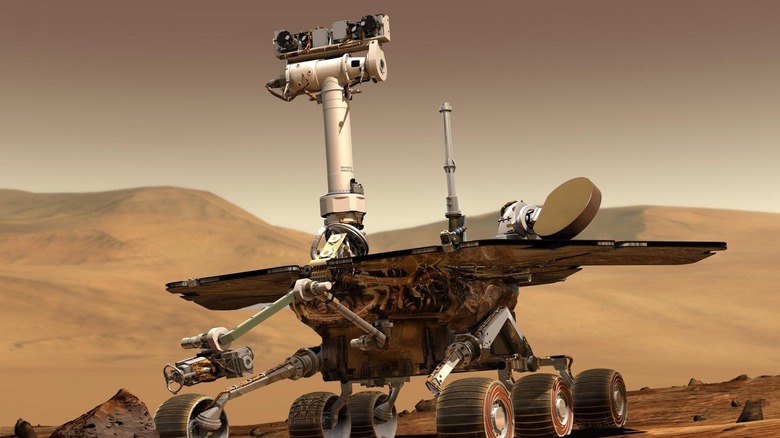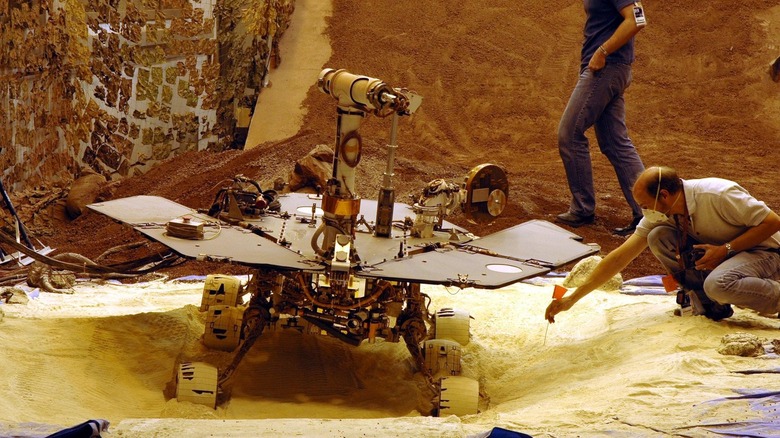Why Building Rover Opportunity Took A Brutal Toll On The Team
Perseverance and Curiosity, the small helicopter Ingenuity, the lander InSight, Mars Odyssey, and Mars Reconnaissance are all scouting the red planet in 2022. They're our eyes and ears on Mars, but they are not the first of their kind. NASA has sent more than 20 missions to Mars, according to its Historical Log. After Pathfinder — the first rover to land on Mars in 1997 — it was time for the rovers Spirit and Opportunity. Little did anyone know that when they landed on Mars in 2004, the duo would exceed all expectations and set records that still stand today.
While both Spirit and Opportunity lived beyond their planned 90-day missions, Opportunity holds the record for the longest rover mission on Mars with an amazing 15 years of work in extreme conditions. It also set the record for most miles driven on the red planet. Beyond its impressive survival and driving skills, Opportunity excelled in scientific work. It discovered evidence that proved Mars was rich in water in the past, and that the conditions on the planet could have sustained microbial life, NASA explains.
The agency lists some of the reasons why Opportunity survived all the challenges Mars threw at it, including its tough build and ability to stay warm during extremely cold nights. Nothing lasts forever, however, and Opportunity sent out its final signal on June 10, 2018 (via JPL). The incredible mission had come to an end because the rover was submerged in a violent and relentless dust storm that covered the entire planet. With batteries draining and no sun to charge, the rover found its final resting place in a spot NASA calls Perseverance Valley in honor of the rover's endurance. The emotional toll of the death of Opportunity was harsh, but given the success of the mission, it was nothing compared to what NASA engineers faced when designing and building the rover.
How NASA built Opportunity and landed it on Mars
Cornell planetary scientist Steve Squyres, Opportunity's principal investigator, told National Geographic that the miracle was not that Opportunity lived 15 years but that it made it to Florida for the launch date. "The schedule that we faced to try to do something that had never been done before was just brutal," Squyres explained.
After a decade of pitching Mars rover missions to NASA, the team that would build Opportunity finally received approval from the space agency in early 2000. However, they had planned for a construction timeline of 48 months, and NASA only gave them 34. As National Geographic reports, project manager Peter Theisinger was put in charge of managing the tight schedules. The team got busy with an all-hands-on-deck approach, running 24 hours a day, seven days a week. "We had to bring it all together at once," Trosper said. NASA engineers were also reinventing the airbag landing system that Pathfinder had used.
After flying over 300 miles into deep space, Opportunity reached Mars — and now it had to land. NASA describes landing on the red planet as "six minutes of terror." Traveling at 12,000 miles per hour, the atmosphere slowed Opportunity down to 1,000 miles per hour. After 100 seconds of free falling, the parachute opened, slowing Opportunity to 200 miles per hour. Just 6 seconds before impact and while around 300 feet off the ground, retro rockets fired, and Opportunity — encased in a cocoon — deployed its airbags to cushion the brutal landing. That was day one of many hard and bright days to come for the rover. "It's sad for me to see Opportunity go; it was always nice to have it there, still driving around as kind of a, 'Wow, that really worked well,'" JPL deputy project manager Jennifer Trosper says.

